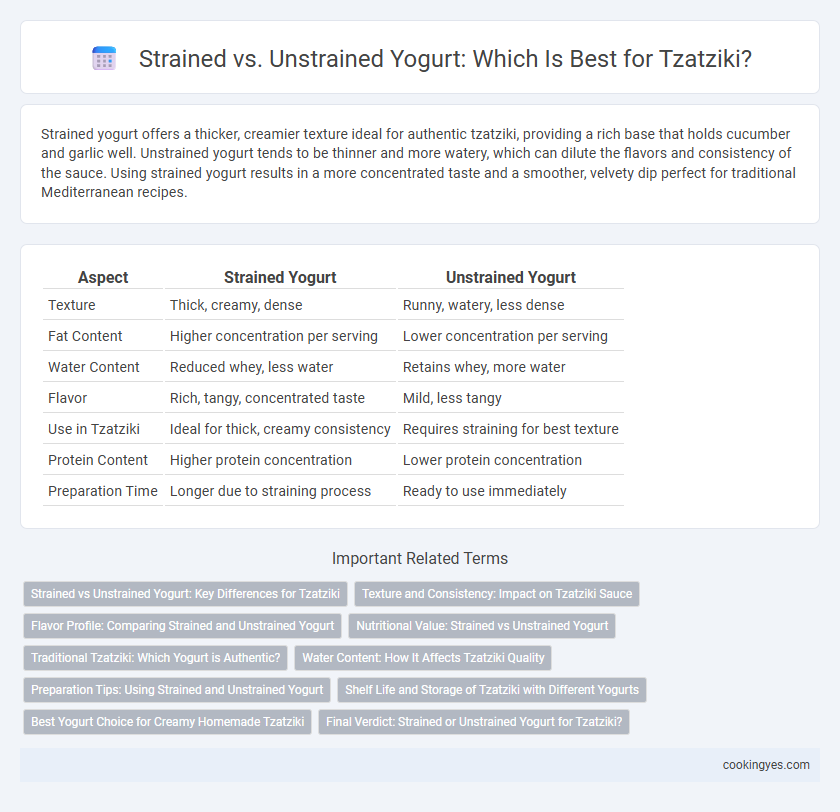Strained yogurt offers a thicker, creamier texture ideal for authentic tzatziki, providing a rich base that holds cucumber and garlic well. Unstrained yogurt tends to be thinner and more watery, which can dilute the flavors and consistency of the sauce. Using strained yogurt results in a more concentrated taste and a smoother, velvety dip perfect for traditional Mediterranean recipes.
Table of Comparison
| Aspect | Strained Yogurt | Unstrained Yogurt |
|---|---|---|
| Texture | Thick, creamy, dense | Runny, watery, less dense |
| Fat Content | Higher concentration per serving | Lower concentration per serving |
| Water Content | Reduced whey, less water | Retains whey, more water |
| Flavor | Rich, tangy, concentrated taste | Mild, less tangy |
| Use in Tzatziki | Ideal for thick, creamy consistency | Requires straining for best texture |
| Protein Content | Higher protein concentration | Lower protein concentration |
| Preparation Time | Longer due to straining process | Ready to use immediately |
Strained vs Unstrained Yogurt: Key Differences for Tzatziki
Strained yogurt, also known as Greek yogurt, contains less whey, resulting in a thicker texture and higher protein content, making it ideal for authentic tzatziki. Unstrained yogurt retains more moisture and a thinner consistency, which can dilute the flavors and require additional draining for optimal sauce thickness. Choosing strained yogurt ensures a creamy, rich tzatziki with concentrated tanginess and a smooth mouthfeel.
Texture and Consistency: Impact on Tzatziki Sauce
Strained yogurt offers a thicker, creamier texture that enhances the smoothness and richness of tzatziki, allowing it to cling better to vegetables or bread. Unstrained yogurt contains more whey, resulting in a thinner consistency that can make tzatziki runnier and less cohesive. Choosing strained yogurt creates a denser sauce with a velvety mouthfeel, while unstrained yogurt produces a lighter, more liquid tzatziki.
Flavor Profile: Comparing Strained and Unstrained Yogurt
Strained yogurt, known for its thick and creamy texture, offers a rich and tangy flavor that enhances the authenticity of tzatziki, providing a more concentrated dairy essence. Unstrained yogurt retains more whey, resulting in a lighter consistency and a subtle milder tartness, which can make tzatziki feel fresher and less dense. Choosing strained yogurt intensifies the sauce's creaminess and depth, while unstrained yogurt delivers a delicate balance suitable for those seeking a lighter dip experience.
Nutritional Value: Strained vs Unstrained Yogurt
Strained yogurt used in tzatziki contains higher protein concentration, lower lactose, and reduced water content compared to unstrained yogurt, enhancing creaminess and nutritional density. Unstrained yogurt retains more calcium and probiotics due to less processing but has a thinner texture with higher carbohydrate and sugar content. Opting for strained yogurt boosts protein intake and makes tzatziki richer and more satisfying while preserving essential nutrients.
Traditional Tzatziki: Which Yogurt is Authentic?
Traditional tzatziki is authentically made with strained yogurt, specifically Greek yogurt, which provides a thick and creamy texture essential for the dish. Strained yogurt has a lower whey content, resulting in a richer consistency that absorbs flavors better than unstrained yogurt. Using unstrained yogurt can produce a thinner sauce that lacks the dense, velvety quality characteristic of classic tzatziki.
Water Content: How It Affects Tzatziki Quality
Strained yogurt has significantly lower water content compared to unstrained yogurt, resulting in a thicker, creamier base essential for authentic tzatziki texture. Excess water in unstrained yogurt can cause the tzatziki to become watery and dilute the flavors, compromising its consistency and taste. Using strained yogurt ensures a rich, concentrated flavor and prevents separation, delivering a higher-quality tzatziki.
Preparation Tips: Using Strained and Unstrained Yogurt
Strained yogurt is ideal for tzatziki due to its thick, creamy texture, which helps achieve the desired consistency without excess liquid. When using unstrained yogurt, it is essential to drain it through cheesecloth or a fine sieve for several hours to remove whey and prevent a watery sauce. For best results, Greek yogurt or labneh can be used as strained alternatives to ensure a rich, authentic tzatziki preparation.
Shelf Life and Storage of Tzatziki with Different Yogurts
Strained yogurt used in tzatziki offers a longer shelf life due to its reduced water content, which inhibits bacterial growth and maintains freshness up to one week when refrigerated at 4degC. Unstrained yogurt-based tzatziki, containing higher moisture levels, tends to spoil faster and is best consumed within 3-4 days to avoid separation and off-flavors. Proper airtight storage in the refrigerator preserves the texture and flavor of tzatziki regardless of the yogurt type, but strained yogurt provides greater stability for extended use.
Best Yogurt Choice for Creamy Homemade Tzatziki
Strained yogurt, often known as Greek yogurt, is the best choice for creamy homemade tzatziki due to its thick texture and reduced whey content, which results in a rich and smooth consistency. Unstrained yogurt contains more liquid, making the sauce thinner and less creamy, often requiring additional straining to achieve the desired texture. Using full-fat strained yogurt enhances the flavor and creaminess, providing an authentic and luscious finish to traditional tzatziki.
Final Verdict: Strained or Unstrained Yogurt for Tzatziki?
For authentic tzatziki, strained yogurt is preferred due to its thicker consistency and creamy texture, which helps achieve the rich, velvety sauce characteristic of traditional Greek recipes. Unstrained yogurt contains more whey and moisture, resulting in a thinner sauce that may dilute the flavors and affect the overall texture. Strained yogurt's concentrated protein and reduced liquid content make it ideal for maintaining the perfect balance of creaminess and freshness in tzatziki.
Strained yogurt vs unstrained yogurt for tzatziki Infographic

 cookingyes.com
cookingyes.com